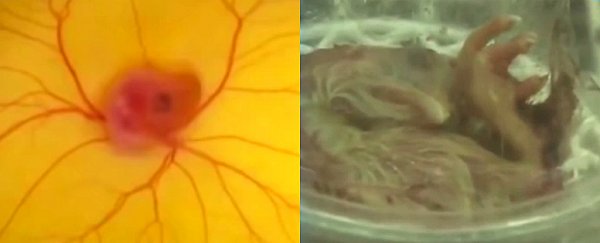
Cracking an egg into a glass bowl and then watching the chick develop, grow, and hatch sounds like the most terrible idea ever. But this adorable and super-enthusiastic video from Japan shows that it can be done - and lets us watch the entire fascinating process first-hand.
If you're anything like us, your first reaction to this is probably "What the eff is going on here?" and your second is, "Why the hell would anyone do this?"
The video doesn't come with subtitles, so it unfortunately doesn't give us many clues. But with the help of Sarah Caroline Bell over at The Huffington Post, we've done some digging, and it turns out the experiment is demonstration of technique developed in Japan a few years ago.
More on how that works later - but first, let's get to the "why?" For years, scientists have been trying to find a way to gain access to baby chicks during development, not only to learn about the growth process, but also to study new regenerative medicine techniques, such as genetic engineering.
This would also be really important for the conservation of endangered birds. Not only could it allow researchers to save chicks when their eggs have been damaged, it could also lead to new options for bird IVF, or even growing vulnerable species inside surrogate eggs.
Although teams have successfully managed to create see-through eggs in the past, the hatching rates using those techniques has generally remained below 50 percent.
As make-shift as it sounds, it turns out that simply growing the eggs without a shell in plastic film has better a better success rate, with scientists able to hatch almost 60 percent of chicks using this technique, as Japanese researchers reported in The Journal of Poultry Science back in 2014.
That's the technique you can see in action in the video above being shown to high school students, and it works like this: first the students crack a store-bought egg into a sterile culture vessel, and cover them in plastic film.
The egg is then artificially fertilised and placed into an incubator. After a few days, we see blood vessels forming and a heartbeat. Then, the chick's features start to develop inside its artificial shell, where it's protected from the bacteria and oxygen of the outside world.
Eventually in the clip above, you see the little guy running around in the lab after hatching.
There are two things to note: firstly, this was all done in a sterilised lab environment, so don't try it at home.
Secondly, this segment was made for TV, so we have no guarantees that the chick at the end is the one we see developing in the egg (or even that the developing shots weren't edited together from multiple egg samples). But research on the technique shows that the odds are in the chick's favour.
Either way, it's an incredibly fascinating insight into the development of a chick, and is a pretty special display of a technique that, in future, could help save vulnerable birds from extinction. We can't stop watching.
